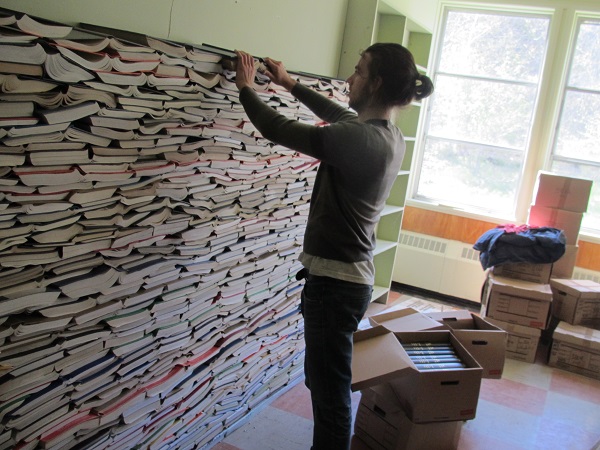2018 School Spending Survey Report
Nova Scotia Sustainability Center Gives New Life to Library Discards
Dalhousie University’s library system was in a bind. Bound books, mostly out-of-date academic journals that had since been uploaded to online databases, had been piling up for years. At nearly 50,000 volumes, the library was running out of space, and shredding didn't work. When builder and inventor David Cameron heard of the problem, he hoped to solve two problems at once, by using them to insulate an abandoned schoolhouse that’s now a community center focused on sustainability.

Building the book wall at the Blockhouse School
He cut costs by having students, who were paying to take a course in earth-plastering, help him complete the wall. “My modus operandi is to turn everything into a learning experience, which at the same time is something people would pay to learn,” Cameron said. “It’s a bootstrapping operation, where you spread these useful skills throughout the community at a very low cost, and also get the job done.” Beyond insulation, the Blockhouse School recently ran an exhibit called “New Life for Old Books,” in which they called for community members to come up with uses for old books in “art, craft, garden, construction, installations, performance” and “anything else you can think of!” Ellis was simply glad to make a dent in the pile of books that have increased as the needs of students dictated that Dalhousie’s libraries devote more space to study room.. “This was a very unique solution. It got rid of a lot of stuff we have no need for, and the books are a viable insulating material,” Ellis said, and then laughed. “Too bad they’re not building a bigger building!” Ellis said that Dalhousie is working in conjunction with other universities in Nova Scotia on a long-term plan for waste and space management, but the immediate problem isn’t fully solved. Embleton-Lake has been coordinating a plan for the remainder of the books that includes paying for “processing”—manually removing the covers and recycling the paper. “Blockhouse School has been a really successful project in and of itself because it’s shown really valuable uses of books and of what can be done,” Embleton-Lake said. “It’s a scientific exercise, though, not something that is going be easily assimilated in the construction industry. But it’s a step in the right direction, of asking what can we do with them? Because we aren’t the only ones with this problem.”RELATED
RECOMMENDED
TECHNOLOGY
ALREADY A SUBSCRIBER? LOG IN
We are currently offering this content for free. Sign up now to activate your personal profile, where you can save articles for future viewing









Add Comment :-
Comment Policy:
Comment should not be empty !!!
Reader
What happens to the air spaces behind that wall of books that are the result of all books not being the same length? Are those pockets not a fire hazard? What is between the exterior wall and the book wall? Great way, though, to give a new life to the books.Posted : Jan 24, 2014 04:28
Babs
To make websites more engaging you should provide links inside the article. You can use names of programs as links so that it just blends in. I'm going to google these names, but just a thought! People like to click and link. Great use of books! I bet it provides a pretty, textured look to the walls if you just left it there without the plaster.Posted : Nov 08, 2013 08:14
David Cameron
Fire isn't an issue-hardbound books will not burn-full stop! OK if you threw one book in a raging fire it would eventually burn. There isn't enough oxygen to support combustion, same as in straw bale construction (and books are much more dense, ie, lacking in spaces for oxygen than straw bales. Also bound journals consist of mostly high-clay content paper which is even more fire-resistant. And they are heavy which is why they don't need to be secured to the wall. Anyone familiar with dry-stone construction will appreciate the similarity when it comes to stability. Gravity works! The books are opened & woven to gain additional stability. And yes, mud-plaster is very strong as long as kept dry which is why we chose an interior wall and with 2 inch styrofoam base to keep above any spilled/leaked water. Final plaster surface can be water-proofed as well. The floor is a ten inch concrete slab, easily capable of bearing the weight of the bookwall. Don't try this on a wooden joist-supported floor.Posted : Nov 08, 2013 04:06
Jon Kozak
Very interesting idea; reminds me of stonework I had the pleasure of creating years ago. My only concern is that's a huge fire-hazard; curious if there is any counter-measure (fire protected barrier) in place to safe-guard this occurring. A different twist would be stacking them upright, with a half-fold, creating a surface to bounce sound off ofPosted : Nov 05, 2013 11:54